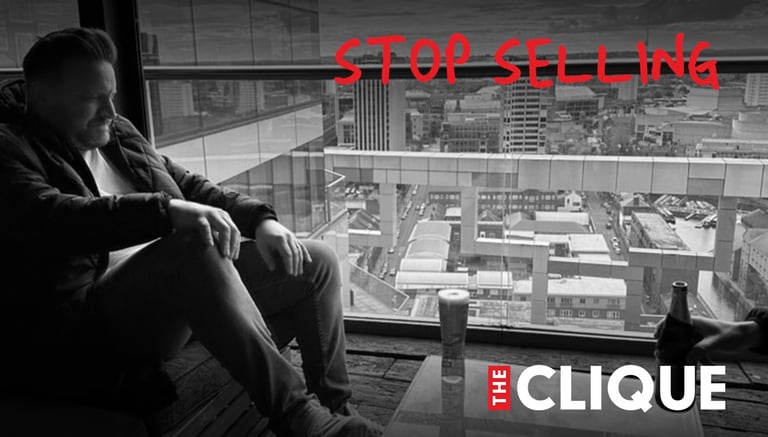Stop 'selling' for more sales.


⚠️ Traditional Sales
If I was going to describe “traditional sales'“ then you might picture the stereotypical car salesman whose tactics revolve around aggressive pitches, cold calling, and high-pressure closing techniques. (And we all hate them)
While these methods might have been effective in the past, the ‘modern’ prospect is likely to be more informed (they know how to use Google), they value transparency and they want to seek out genuine relationships with brands/people.
Digital technology, social media, and the availability of information online have definitely changed how people buy products and services.
The thing is, when you think about how you sell - you probably don’t think that you fall into the trap of becoming that ‘sales’ person - the one that wants someone to buy their product, you want to be the salesperson who works in some holistic way and never works in the way I described.
The problem is - you probably are just selling that product/service in the way I described.
We all do it - we drop the ball and we revert back to our training/experience.
🫣 What we do
It’s the standard way of working, we focus on what we can bring to our clients - and when I say ‘bring’ - you know I mean sell.
If you’re selling a boxed product which solves a problem - you’ll either focus on the problem or the product.
If you’re selling an online course which creates value - you’ll either focus on the value or the contents of the course.
If you’re selling a car with certain features - you’ll probably focus on the features.
It’s the norm - it’s how we’re taught to sell, remember every sales guru says to focus on the benefits and not the features - but we all revert back to our safe zone and we end up selling some of the features some of the time.
Those who keep up with the sales gurus don’t fall foul of this trap and instead lean into the benefits - they preach about how this product or service can offer value and how it’s going to offer improvements.
This is where 80% of us sit - we fall into one of these two camps - we either preach about the features of our product or we relay the benefits.
But there we’re not elevating ourselves into the top 20%.
👀 How I see it.
So if 80% of salespeople work in the ‘normal’ way - what do the other 20% do?
The top 20% understand the past, the present and can predict the future. They understand the market trends, they understand what’s coming down the line and they can save their clients precious time and money and they can see it all clearly.
They can understand what impact their product/service has and what their positioning within the market is.
Its called being ‘consultative’ and this is where the elite salespeople excel.
This is about being way past the specific product or service you’re offering. Don’t get me wrong, while the product or service value (offered by the your company) is still essential, the conversation is much broader at this level.
We’re starting to talk about industry trends, emerging challenges, strategic opportunities, and how the client can navigate these factors successfully.
But the relationship that you hold as a consultative salesperson with your client becomes much deeper - you can act as an extension to your clients business so you get to think years ahead - the long term sale becomes the norm, you understand your client's long-term goals, challenges, and opportunities and you’re able to spot opportunities for improvement before the client.
Anthony Iannarino, a renowned sales leader and former guest of the SalesChange podcast, developed the "Level 4 Value Creation" model which he often describes as a value ladder in sales.
This model outlines different levels at which salespeople can create value for their clients, with each subsequent level being more strategic and impactful. The highest level in Iannarino's value ladder is Level 4: Strategic Partner.
It is this level of value that you should strive to offer your clients.
🧠 How can we elevate ourselves?
I’ve spent time thinking about how I operate and how I differ in my practices from a ‘regular’ salesperson and I’ve come up with the following 4 step plan to help you stop ‘selling’ and become more consultative;
Research: You have to spend time and energy to understand your client's industry, trends, challenges, and opportunities. The best way to do this would be to carry out a SWOT analysis on their particular industry. Please remember - this is about their industry and not yours! You may be the subject matter expert in selling that car but it’s not where your customer sits.
Ask Questions: Be continuously inquisitive. Only by asking questions (about the research you’ve done in Q1) can you understand your clients specific needs. If you ask insightful questions to understand their long-term vision, strategic goals, and pain points, then you can use this to tailor your offerings and insights more strategically.
Don’t let them down: You have to be consistently above your competitors - This means delivering on promises, being punctual, and ensuring that the quality of products or services remains high. You have to be open about the capabilities and limitations of your product or service. If something isn't the right fit for the client, tell them.
Finally, show that you care about your client and their business - this can be shown using small gestures, such as sending flowers to a client if they have a baby or a card if it’s their birthday.
Feedback Loop: One of the very first actions that I took when I took over at SAFI Valves was to meet with most of our clients and I got feedback on our product (or service) - I then used that feedback to make improvements. This collaborative approach showed a commitment to continuous growth and value delivery.
⭐️ What can you do now?
That’s the question I want you to ask yourself - what can you do right now with your existing list of clients to show that you care?
What can you do to elevate yourself from the competition because if you stay the same and play the same game as your competitors then you’ll likely end up in the trenches playing the same game.


